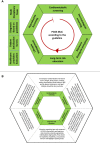A systematic review of models of care for polycystic ovary syndrome highlights the gap in the literature, especially in developing countries
- PMID: 37614710
- PMCID: PMC10443706
- DOI: 10.3389/fendo.2023.1217468
A systematic review of models of care for polycystic ovary syndrome highlights the gap in the literature, especially in developing countries
Abstract
Introduction: The aim of the study was to identify available polycystic ovary syndrome (PCOS) models of care (MoCs) and describe their characteristics and alignment with the international PCOS guideline.
Methods: Ovid MEDLINE, All EBM, PsycINFO, Embase, and CINAHL were searched from inception until 11 July 2022. Any study with a description of a PCOS MoC was included. Non-evidence-based guidelines, abstracts, study protocols, and clinical trial registrations were excluded. We also excluded MoCs delivered in research settings to minimize care bias. Meta-analysis was not performed due to heterogeneity across MoCs. We describe and evaluate each MoC based on the recommendations made by the international evidence-based guideline for assessing and managing PCOS.
Results: Of 3,671 articles, six articles describing five MoCs were included in our systematic review. All MoCs described a multidisciplinary approach, including an endocrinologist, dietitian, gynecologist, psychologist, dermatologist, etc. Three MoCs described all aspects of PCOS care aligned with the international guideline recommendations. These include providing education on long-term risks, lifestyle interventions, screening and management of emotional well-being, cardiometabolic diseases, and the dermatological and reproductive elements of PCOS. Three MoCs evaluated patients' and healthcare professionals' satisfaction, with generally positive findings. Only one MoC explored the impact of their service on patients' health outcomes and showed improvement in BMI.
Conclusion: There is limited literature describing PCOS MoCs in routine practice. Future research should explore developing cost-effective co-created multidisciplinary PCOS MoCs globally. This may be facilitated by the exchange of best practices between institutions with an established MoC and those who are interested in setting one up.
Systematic review registration: https://www.crd.york.ac.uk/prospero/display_record.php?RecordID=346539, identifier CRD42022346539.
Keywords: PCOS; model of care; multidisciplinary care; polycystic ovary syndrome; quality of life.
Copyright © 2023 Melson, Davitadze, Malhotra, PCOS SEva working group, Mousa, Teede, Boivin, Thondan, Tay and Kempegowda.
Conflict of interest statement
AM is supported by a biomedical research fellowship provided by the National Health and Medical Research Council (NHMRC) of Australia. HT is an NHMRC Medical Research Future Fund Practitioner Fellow. CT is supported by the NHMRC Centre for Research Excellence in Women's Health in Reproductive Life. The remaining authors declare that the research was conducted in the absence of any commercial or financial relationships that could be construed as a potential conflict of interest.
Figures




References
-
- Yildiz BO, Bozdag G, Yapici Z, Esinler I, Yarali H. Prevalence, phenotype and cardiometabolic risk of polycystic ovary syndrome under different diagnostic criteria. Hum Reprod (2012) 27(10):3067–73. - PubMed
-
- Azziz R, Carmina E, Dewailly D, Diamanti-Kandarakis E, Escobar-Morreale HF, Futterweit W, et al. . Positions statement: criteria for defining polycystic ovary syndrome as a predominantly hyperandrogenic syndrome: an androgen excess society guideline. J Clin Endocrinol Metab (2006) 91(11):4237–45. - PubMed
-
- Barber TM, Franks S. Obesity and polycystic ovary syndrome. Clin Endocrinol (2021) 95(4):531–41. - PubMed
-
- Lim SS, Davies MJ, Norman RJ, Moran LJ. Overweight, obesity and central obesity in women with polycystic ovary syndrome: a systematic review and meta-analysis. Hum Reprod Update (2012) 18(6):618–37. - PubMed
Publication types
MeSH terms
LinkOut - more resources
Full Text Sources
Medical
Miscellaneous

